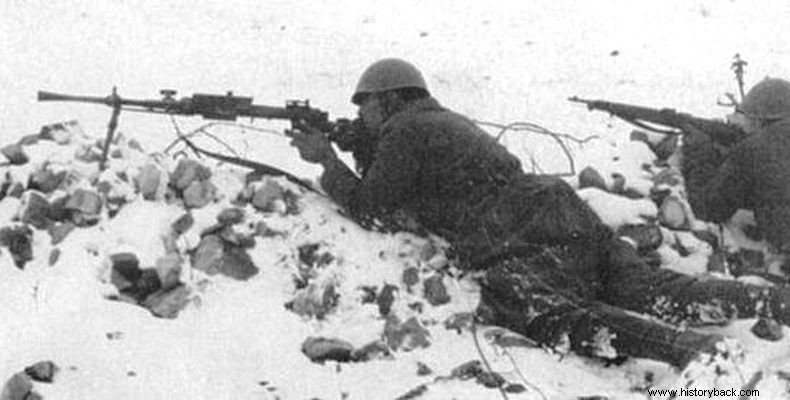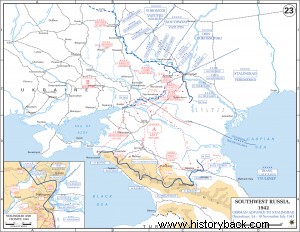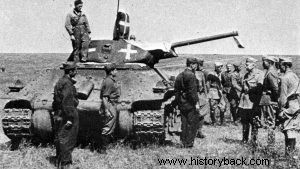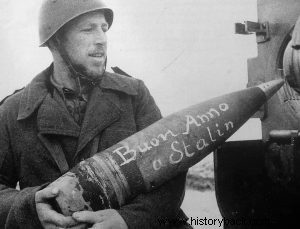
The Italian 8th Army was formed by Mussolini to reinforce Germany's ally in the "anti-Bolshevik crusade" on the Eastern Front. At the beginning of Operation "Barbarossa" the Italian dictator had reinforced the Germans with an army corps.
But in 1942 it was clear that the German war effort in the USSR needed to be strengthened after the defeat on the brink of Moscow. So Mussolini decided to upgrade the Italian presence on the Southern Front.
Organization
The 8th Army had 200,000 Italians and extended a total of 10 divisions. Of these, four were infantry, the 2nd Infantry Division (MP) Sforzeca, the 3rd MP Ravenna, the 5th MP Coseria and the 156th MP Vicenza. Three were Alpinist divisions, the 2nd Alpinist Division (MA) Tridentina, the 3rd MA Giulia and the 4th MA Kunenze. Finally, it had the 9th Pazubio and 52nd Torino Motorized Infantry Divisions (MI) and the 3rd Cavalry Division (MI) d'Aosta.
These divisions made up three army corps, the 2nd, the 35th and the Mountaineer Army Corps (SSA). The 35th had the fast-moving divisions, the 2nd the MPs except for Vicenza which was under the direct command of the army, and the SSA the MAs. Also attached to the 8th Army was the Croatian Legion and three "legions" (regiments) of Blackcoats. The Germans reinforced the 8th Army with two of their own MPs, the 62nd and 298th.
In November 1942 the 8th Army had 988 guns of all types, 420 mortars, 17,000 vehicles of all types and 25,000 horses. She was also allocated 12 German Pz IV tanks, but as far as Italian tanks were concerned she had L6/40 light tanks . As far as anti-tank weapons are concerned, the Italians only had the absolutely ineffective 47mm guns and those in limited numbers. An air wing with a total of 64 aircraft was made available for direct support of the army. General Italo Gariboldi assumed command of the army.
The Italians in battle
The 8th Army was in action from July 1942. From 17 – 20 July the Italians fought hard but victoriously in the area south-east of Kharkov, losing 630 men but inflicting over 5,000 Soviet casualties. At the same time, the 3rd MI reinforced the Germans in the battle of Serafimović. The Italians fought well and inflicted heavy casualties on the Soviets – about 6,000 casualties to their own 1,900.
On August 12, however, the Soviets attacked with 30,000 men and tanks against the 2nd MP Sforcheka, in the Don, which they almost destroyed. The remnants of the division nevertheless repulsed further Soviet attacks from 20–24 August until reinforcements arrived and the Soviets retreated. Italian losses were heavy – 6,800 dead, wounded, missing.
However on August 24 the Italian Cavalry Regiment of Savoy charged against the enemy and routed 2,500 Soviets losing only 84 men . The 8th Army then took over covering the left wing of the German 6th Army fighting at Stalingrad, along with the Germans' Hungarian and Romanian allies. The Italians were assigned to cover an unrealistically large front sector – 250 km.
The Italian soldiers also due to the winter could only establish very rough defensive positions along the west bank of the Don River. On November 19, the Soviets launched a major offensive that resulted in the heavy defeat of the Romanian forces and the encirclement of the German 6th Army.
Successive blows
On December 11, the Soviets launched Operation Saturn with the goal of destroying all Italian, Hungarian, and Romanian forces on the Don. Operation "Little Saturn" was organized specifically against the Italians.
The Soviet 63rd Army, reinforced with a large number of tanks and supported by strong air power, attacked the sector of the front held by the Italian 3rd MP Ravenna and 5th MP Coseria. The two Italian MPs were attacked by 15 Soviet rifle divisions supported by at least 100 T-34 tanks against which the Italians simply had no defense.
To their credit, the Italians held out until December 19 when both MPs, almost disbanded, were ordered to retreat. The Soviets had attacked both the Romanians covering the Italian right and the Hungarians covering the Italian left. The defeat of their allies also sealed the fate of the Italians who now faced the attack of the Soviet 1st Guards Army.
Defending the offensive sector were the German 298th Infantry Division – the 62nd Infantry Division had been allocated to the German 6th Army – the 3rd MI, the 52nd Infantry Division Torino, the 9th Infantry Division Pazubio and the remnants of Sforzecca. The Italians held out for 11 days, but finally crashed.
Already the right wing and center of the 8th Army had been defeated. On January 14, the Soviet 6th Army in turn attacked the Italian SSA which formed the left wing of the 8th Army. The Mountaineers were crushed in their turn although they fought bravely. Only MA Tridentina managed to retreat with some consistency. The other two MAs were disbanded trying to escape the Soviet cordon in Nikolayeva.
The remnants of the 8th Army returned badly to Italy. The total losses of the 8th Army on the Eastern Front between August 1942 and February 1943 exceeded 120,000 thousand men.
It was a disaster but one that had a logical explanation for any cool-headed observer other than the foolish Mussolini who sent a woefully outfitted and, by all accounts, ill-prepared army to sacrifice himself for his own glory on the Russian steppe.


An Italian-captured T-34 main battle tank is presented to the commander of the 8th Army, General Gariboldi.

